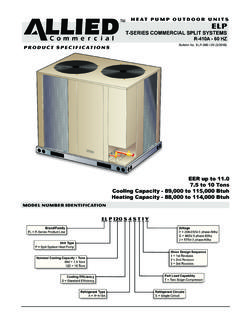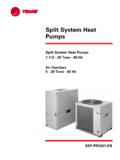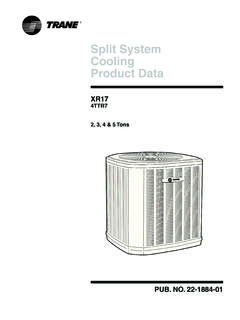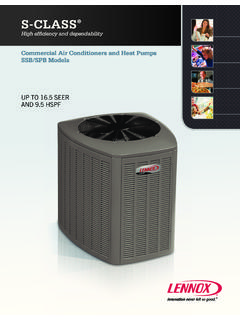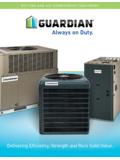Transcription of e Variable Refrigerant Flow 101- - ASHRAE - Home …
1 EPeople and ideas you can 2014 Daikin Applied Variable Refrigerant Flow 101-Bill ArtisPageYour Presenters 2014 Daikin Applied 2 Bill Artis LEED AP BD+CBusiness DevelopmentDaikin NYASHRAE LI Member, BOGASHRAE TC Member Guideline 41 Project Committee: VRF Design, Installation, and Commissioning Handbook: Systems and Equipment 2016 Variable Refrigerant Flow , ch18~10yrs in HVAC Resources: ASHRAE Handbook: 2016 Systems and Equipment, ch18 Variable Refrigerant Flow VRF Design and Application Webinar- ASHRAE Learning Institute (spring)PageAgenda Review system Types and Architecture Describe Basic Sequence of Operations Discuss design and application considerations for equipment, piping, and airside. Introduction to the Dark Side of ASHRAE 2014 Daikin Applied 3 PageVRF Architecture & system Types 2014 Daikin Applied 4 PageVRF Overview + Architecture Indoor(fan coil)unit(s)connectedtoan outdoor(condensing)unit Up to64unitsonasingle refrigerantpiping network One-One configurations Availableineitheraircooled orwatercooled heat Pump or heat RecoveryVRFC onceptVRFO verview Developed in 1982 ~5% Market Share in NA Expected to reach ~$10,251MM in 2019 PageNote.
2 Unitsare notforcedinto heatingorcoolingIfdemandisnotrequireda FCUwillgoontofan onlyHeat PumpSeriesWhole systemisin coolingORheatingmodePageHeat RecoverySeriesThesystemcancoolANDheatsim ultaneouslyThe systemwill ALSO provideaHeat RecoveryProcessPageHeat Recovery Control Units 2014 Daikin Applied 8 HRCU for 3 Pipe heat RecoveryHRCU for 2 Pipe heat RecoveryEach port is capable of operating in heating or cooling independent of the other portsPageBasic Operation of VRF Systems 2014 Daikin Applied 9 PageSequence of Operations-Indoor Unit Refrigerant Flow Control Control Refrigerant flow based on enter/leaving Refrigerant temp at coil Superheat control for cooling /subcoolingcontrol for heating Adjusts target as error between thermostat set-point and room temperature changes Fan Control Fan cycling or continuous operation User-set Single Zone VAV type fan control capable 2014 Daikin Applied10 PageRoom CapacityControlVRFfan coilshave 3thermistorsensors Thesensorsignalsareusedtoregulaterefrige rantvolumethroughthefancoilusingProporti onal,Integral&Derivative(PID)control,toc orrectdeviationfrom target temperaturevaluesbyadjustingtheElectroni cExpansionValveinpulsestomodulateopenand closeIndoor FanCoilUnitIndoorUnit :ReturnAirR2T:SaturatedLiquidPipeR3T:Gas PipeTH1: RemoteControllerSensorTSET:RemoteControl lerSet PointHorCTempSetpointTSETTH1 PageSequence of Operations-CondenserTwo types of control: Refrigerant Volume w.
3 Constant Saturation Temperature Adjusts compressor speed/mass flow with system load Refrigerant Volume + Saturation Temperature Reset In addition, adjusts saturated Refrigerant temperature OA Conditions Thermostat set-point error for each unit Refrigerant temperatures at coil Can be configured for capacity or efficiency preference Identifies critical zone 2014 Daikin Applied12 PageSequence of Operations-Mode ChangeoverHeat Pump Entire system is either in cooling or heating mode Indoor unit will operate in Fan Only when there is no demand Mode changeover can be accomplished based on Outside ambient Averaging temperatures from all units on system Weighted vote from all units based on demand and priority Critical zone unit 2014 Daikin Applied13 system 1 CoolingCoolingHeatingHeatingSystem 2 PageSystem CapacityControlCondensingUnit BrainControlSystemCondenserControlInvert erControl SetsTargetlow&highpressurevaluesattheCon denser Fan Coils LocalRemote ControllersinitiateasystemThermo ONwitha1 deviationfromsetpoint LocalRemote ControllersinitiateasystemThermo OFFwhenallsetpointsare
4 ReachedCOOLO peration Detectsthesystemoperating suction pressureatthecondenser onceevery20seconds& TargetEvaptempHEATO peration Detectsthesystemoperatinghighpressureatt hecondenseronceevery 20seconds &TargetCondtemp Adjustscompressorspeed(capacity)up ordown to correctdeviationfromthetargetpressureval ues(systemload)52~399 HzApplied frequency14%100%PageSequence of Operations-Condenser 2014 Daikin Applied15 Lower Lift = Less Work = Lower power input Think Chilled Water or Boiler temperature reset function What if We Control the Refrigerant Temp?PressureEnthalpy4292105 SAT. LIQUIDSCTSSTHeat RejectionReduced LiftRefrigerant Effect(Capacity)SAT. VAPORA321 PressureEnthalpy4252 SAT. LIQUIDSCTSSTHeat RejectionReduced LiftRefrigerant Effect(Capacity)SAT. VAPORA21923 The Future??NowPageSequence of Operations-Mode ChangeoverHeat Recovery system provides simultaneous heating/ cooling ( heat recovery) Changeover zone is at each heat recovery control unit Or zone port on a multi port box Indoor unit will operate in Fan Only when there is no demand Mode changeover can be accomplished based on Outside ambient/ Calendar Averaging temperatures from all units on system Weighted vote from all units based on demand and priority Critical zone unit (aka Master Unit ) 2014 Daikin Applied16 PageHeat Recovery-Three PipeHeat Recovery UnitSub Cooled LiquidHot GasSuction GasPageHeat Recovery Unit Control-Three PipeThe heat -Exchanger is Divided in Three CircuitsUpper(Condenser or Evaporator)Middle(Condenser or Evaporator)Lower(Inverter cooling ) The heat -Exchanger is Divided in Three CircuitsPageHeat Recovery Unit Control-Three PipeOperation.
5 Warm Weather100% CoolingPageHeat Recovery Unit Control-Three PipeCoolingCoolingFan/ Thermo-OffShown in 100% cooling operationHeat Recovery UnitPageHeat Recovery Unit Control-Three PipeOperation: Cold Weather100% HeatingPageHeat Recovery Unit Control-Three PipeHeatingHeatingFan/ Thermo-OffShown in 100% Heating operationHeat Recovery UnitTrickle of hot gas to keep coil warmPageHeat Recovery Unit Control-Three PipeOperation: Mild60% cooling / 40% HeatingOr Vice-Versa; other parameters of operation can change to suit any combinationPageHeat Recovery Unit Control-Three PipeHeatingCoolingFan OnlyShown in simultaneous heating and cooling operationHeat Recovery UnitPageHeat Recovery-Two Pipe 2014 Daikin Applied 25 Sub Cooled LiquidHot GasSuction GasCoolingCoolingCoolingHeatingHeatingPa geSequence of Operations-DefrostCondenser Defrost Control Demand Based (Time and/or Temperature) Actual SOO varies with OEM Sequences for HP and HR Full Changeover (All heat Pump, Most heat Recovery) Partial Changeover/Continuous Heating (Some heat Recovery Models) Combination Defrost (Some heat Recovery Models)
6 Partial defrost with full defrost every 3rdcycleIndoor Unit Defrost Control Full Changeover Fan off, or Fan-on plus supplemental backup Partial Defrost Fan goes to lowest speed 2014 Daikin Applied26 PageSequence of Operations-Defrost 2014 Daikin Applied27 Partial Defrost OperationFull Changeover DefrostPageApplicationand Design Considerations for Selecting a VRF system 2014 Daikin Applied 28 PageEfficiencyMetricsHowarewegoingtomeas urethis?EER(95F)IEERCOP(47 F)COP(17 F)SCHEIn 2010,IEER(IntegratedEnergyEfficiencyRati o)replaced IPLV (IntegratedPart LoadPerformance)asthemeans tomeasurepartloadperformanceofcommercial HVAC systemsover65,000 Btu/hSystemfullloadcoolingoperationSyste mseasonalcoolingefficiencyFull LoadHeatingPerformanceat47 FFull LoadHeatingPerformanceat17 FSimul taneousCoolingandHeatingEfficiency(appro x50 50%)PageVRF Systems <65 MBH are tested to AHRI 210/240 AHRI Directory Listing: Variable Speed Mini-Split and Multi-Split Air Conditioners and heat PumpsEfficiency Requirements-NYCECC PageVRF Systems >65 MBH are tested to AHRI 1230 AHRI Directory Listing.
7 VRF Multi-Split Air Conditioning and heat Pump Equipment Table (12)Efficiency Requirements-NYCECCPageVRF Efficiency 2013 CurrentVRFsystemsin the USmarket tendtosignificantlyexceedtheminimum efficiencyrequirementssetfor electricallyoperatedairtoairVRFsystemsPa geBasics VRF systems can be over connected (130-200% as rule of thumb) to take advantage of diversity Connection Ratio: Sum of total indoor unit capacity (nominal)/ Condenser capacity (nominal) Based on nominal cooling capacities Some unit configuration limits based on OEM guidelines This is not a reason to ignore rated capacity at design conditions Peak: Largest sum of all simultaneously occurring zone/space loads (aka building peak or Diversified load) Space Load: Largest load requirement per individual zone or space 2014 Daikin Applied33 PageLoads and system Sizing34 Indoor units sized for zone or space load Condenser sized for Peak (diversified) load Size based on dominant load Consider minimum turn-down requirements Consider need for simultaneous heating/coolingConnected Load: 109 MBH (10 Tons)Peak Load: (8 Ton)Diversity Factor=.
8 86 Connection Ratio= 125%26,075 PageIndoor Unit Selection Considerations 2014 Daikin Applied 35 PageStandard IndoorUnit Options100%OutsideAir ProcessingUnitEnergy RecoveryVentilator300 1200 CFMV entilationUnitsDuct freeUnitsWallMounted2 x2 4 Way CassetteCeiling SuspendedExposed FloorStanding3 x3 RoundFlowCassette4 Way Cassette1 WayCassetteVertical DuctedDC Ducted ConcealedConcealed CeilingSlimDuctConcealedConcealed FloorStandingDuctedUnitsNumerous Types& Models(typically 7to96 MBH)PageIndoor Unit Selection Criteria 2014 Daikin Applied 37 Standard Unit CharacteristicsCoil Design ~3 Row, 13-15 FPI Downstream of fan (blow-through) Electronic Expansion ValvesFan and Drive Design Centrifugal, synthetic material Direct Drive Mostly ECM motors, some PSC .1 to .35kW input powerSound Information Typically only sound pressure data available Typically rated to ISO standard or OEM specific criteriaPageIndoor Unit Selection CriteriaRecommended Operating RangeCooling: 58 FWB to 82 FWBH eating: 58 FDB to 80 FDB 50 FDB EAT allowed for short-term warm-up periodNominal Capacity Entering Air Conditions cooling nominal EAT 80 FDB/67 FWB for all types Heating nominal EAT is 70 FDB 2014 Daikin Applied 38 PageIndoor Unit Selection CriteriaSelection CriteriaCapacities Size for dominant load (heating v.)
9 cooling )Sensible heat Ratio Between .70 to .82 at nominal conditions Unit type Model and OEM Capacity to cabinet sizeAirflow 350 to 450 CFM/Ton Same variables as SHR Must factor in ESP for accurate rating 2014 Daikin Applied 39 PageConfigurable & Custom Air Handler IntegrationRecent Project Spec: MERV 8/13 Pre and Final Filter HW Coil 3000 CFM Stainless Steel Liner Double-Wall R-13 TESP (2 ESP)Discharge Air Temperature Control SZVAV VAV CV+RHPageOutside Air ConsiderationsDirect Method:Mix a percentage of OA with return air at unit. OA is not pretreated, application conditions apply. Must be rated on MA tempIntegrated Method: OA is pretreated by DOAS or ERV units before being supplied with indoor units. Must be rated on MA Method: DOAS provides 100% conditioned OA direct to space. VRF only has to handle space loads; DOAS can handle some or all space latent 2014 Daikin Applied 42 PageOutside Air ConsiderationsDirect Method:Mix a percentage of OA with return air at unit.
10 OA is not pretreated, application conditions apply. Indoor units must be rated on MA tempExample:Total Supply= 1375 CFMOA= 275 CFM at 95 FDB/75 FWBR eturn= 1,1100 CFM at 75 FDB/64 FWBM ixed Air= 78 FDB/66 FWB 2014 Daikin Applied 43 PageOutside Air ConsiderationsIntegrated Method: OA is pretreated by DOAS or ERV units before being supplied to indoor units. Indoor units must be rated on MA temp. 2014 Daikin Applied 44 PageSECTION MC 403 MECHANICAL system ventilation system ventilation efficiency (Ev) shall be determined using Table or Appendix A of ASHRAE 2014 Daikin Applied 45 DAT Temperature and DistributionPageOutside Air ConsiderationsDecoupled:DOAS provides 100% conditioned OA direct to space. VRF only has to handle space loads; DOAS can handle some or all space latent 2014 Daikin Applied 46 PageCondenser Selection Considerations 2014 Daikin Applied 47 PageOutdoorUnit RangeHeatPumpHeatRecoveryHeatPump (SinglePhase)AirCooled6 42 tons5 48tons3 5tonsWaterCooled5 ~40tons5 ~40tonsPageCondenser Selection Criteria 2014 Daikin Applied 49 Air Cooled Unit CharacteristicsCompressor(s)/Condenser Modules Mostly inverter, some digital scrolls and constant volume Single or dual compressors Single modules up to 14+tr, manifold for higherFan and Drive Design (Air Cooled) Propeller, synthetic material Direct drive, ECM, Variable speedSound Information Typically only sound pressure data availableTypically rated to ISO standard or OEM specific criteriaFoot Print Single modules range from 36 to 48 W x 30 D x 66 H PageAir Cooled Reference:6 Ton Module MCA= 30A14 Ton Module MCA= 61 AWater Cooled Reference.
